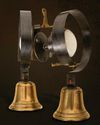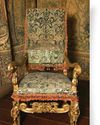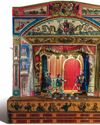
Kokeshi are one of Japan’s most intriguing folk art traditions. With no arms, no legs, and oversized heads, the dolls spark very different reactions. ‘Some people immediately fall in love with them,’ says Michael Horner, a dealer who specialises in Japanese antiques, ‘but others find them a bit disturbing.’
Very little documentation exists to explain their roots, but kokeshi were originally made in Tohoku, a sparsely populated region of mountains, forests, and volcanoes to the north of Japan’s main island. Michael loves the romance of the dolls’ origins: ‘Centuries ago, during the long, harsh winters, local farmers and artisans made the simple wooden dolls to while away the time and give their children something to play with. In the 1800s, outsiders started visiting the region’s hot springs, and they wanted a memento to take home. Just like when the Georgians visiting spa resorts in the UK started buying papier mâché goods, kokeshi were soon popularised as souvenirs, too.’ Manami Okazaki, an author of books on kokeshi, a curator and collector, explains that kokeshi are now part and parcel of Japanese culture: ‘Other cultures have their own doll-making traditions, like the Russian nesting dolls. Whereas Russian dolls are maximalist, with lots of colour and lots of pattern, the Japanese dolls are very minimalist. They’re an aesthetic exercise in how much you can take away.’
For Manami, it’s their simplicity that makes kokeshi so appealing. ‘Although they’re very simple, they’re also incredibly expressive. Their faces are painted with simple brushstrokes and are quite ambiguous, but they have a calming presence. Lots of people feel an emotional affinity with them.’ Michael agrees – one of his customers is a psychologist, who finds the dolls help their patients to open up.
This story is from the March 2022 edition of Homes & Antiques.
Start your 7-day Magzter GOLD free trial to access thousands of curated premium stories, and 9,000+ magazines and newspapers.
Already a subscriber ? Sign In
This story is from the March 2022 edition of Homes & Antiques.
Start your 7-day Magzter GOLD free trial to access thousands of curated premium stories, and 9,000+ magazines and newspapers.
Already a subscriber? Sign In

Lisa Coppin
The Cotswold Company’s chief creative officer shares the pieces that mean so much to her

TRAVEL
Six of the best pineta, plus a festive trip to Covent Garden. Review of The Orange, Belgravia by Katie Pike, travel stories

OLD SHEFFIELD PLATE
Stumbled upon by chance, this ingenious material was a more affordable option than solid silver, and well-preserved examples are particularly desirable today

Merrily on high
Summoning servants since the 1700s, bell boards create instant English country-house style (even if you don't have any servants). Emma Longstaff dons her pinny

Let it snow
Nostalgic, magical and highly collectable, snow globes are curious objects of wonder that never fail to instil joy

Velvet Crush
Once the preserve of the wealthy, velvet finally touched all levels of society, thanks to advances in its production process

Celebrating in the Stable
Antiques dealer Julia von Hülsen specialises in Gustavian pieces - all of which look perfectly placed in her German home

THE SHOW MUST GO ON
Victorian toy theatres charming and exquisitely designed miniature worlds have inspired theatre royalty for decades. Today, the tradition is being kept alive by a small but talented network of makers

NICHOLAS LEES
The ceramic artist talks to Dominique Corlett about new ways of working with clay and blurring the edges of solid objects

Candy CHRISTMAS
Pastel hues, vintage decorations and bowls of sweet treats: the festive run-up is gloriously joyful at Bettina Færgeman's historic Copenhagen apartment, where there's an emphasis on entertaining...